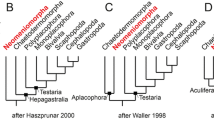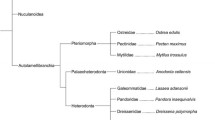Abstract
Polyps of the family Cassiopeidae (Cnidaria: Scyphozoa) can reproduce asexually by forming a ciliated swimming stage, the planuloid. It is externally similar to the planula larva and has traditionally been referred to as the planuloid bud. Using phalloidin labeling, we described the development of the muscular system in planuloids of Cassiopeia xamachana during growth and metamorphosis into the polyp. Early growth stages of the planuloid involve septal muscle bands of the polyp but after separation from the mother organism it forms its own musculature de novo. Muscular elements of the newly separated planuloid are represented by short disordered fibers and four main groups of longitudinal muscles. These elements are the primary musculature of the future polyp. During further development the planuloid grows, changes in shape from elongated to triangular and starts to form the musculature of the hypostome and the tentacles anlages. By the time of settlement the muscular groups form four bands. Process of musculature formation in planuloids differs from that in scyphozoan planulae, which lack well-developed muscular elements. The formation of planuloids might be a modification of lateral budding, with the development of the daughter polyp occurring distantly from the mother organism. These stages could not be called true buds because of their independent growth, and so the term “planuloid bud” is misleading. We argue that the planuloid is the best name for this stage since it reflects its biology and at the same time emphasizes its similarity to the planula larva.







Similar content being viewed by others
References
Adler L, Jarms G (2009) New insights into reproductive traits of scyphozoans: special methods of propagation in Sanderia malayensis Goette, 1886 (Pelagiidae, Semaeostomeae) enable establishing a new classification of asexual reproduction in the class Scyphozoa. Mar Biol 156(7):1411–1420. https://doi.org/10.1007/s00227-009-1181-6
Arai MN (2009) The potential importance of podocysts to the formation of scyphozoan blooms: a review. Hydrobiologia 616:241–246. https://doi.org/10.1007/s10750-008-9588-5
Arai MN (2012) A functional biology of Scyphozoa. Springer Science & Business Media, New York
Berking S (2003) Principles of branch formation and branch patterning in Hydrozoa. Int J Dev Biol 50(2–3):123–134
Bigelow RP (1900) The anatomy and development of Cassiopea xamachana. Boston Society of Natural History, Boston
Blanquet RS (1972) Structural and chemical aspects of the podocyst cuticle of the scyphozoan medusa Chrysaora quinquecirrha. Biol Bull 142(1):1–10
Brusca RC, Moore W, Schuster SM (2016) Invertebrates, 3rd edn. Sinauer Associates Inc Publishers, Sunderland
Calder DR (1982) Life history of the cannonball jellyfish, Stomolophus meleagris L. Agassiz, 1860 (Scyphozoa, Rhizostomida). Biol Bull 162(2):149–162
Cartwright P (2003) Developmental insights into the origin of complex colonial hydrozoans. Integr Comp Biol 43(1):82–86
Chapman DM (1968) Structure, histochemistry and formation of the podocyst and cuticle of Aurelia aurita. J Mar Biol Assoc UK 48(1):187–208
Dunn CW, Wagner GP (2006) The evolution of colony-level development in the Siphonophora (Cnidaria: Hydrozoa). Dev Genes Evol 216(12):743–754
Fautin DG (2002) Reproduction of cnidaria. Can J Zool 80(10):1735–1754
Fischer AB, Hofmann DK (2004) Budding, bud morphogenesis, and regeneration in Carybdea marsupialis Linnaeus, 1758 (Cnidaria: Cubozoa). Hydrobiologia 530(1–3):331–337
Fleck J, Hofmann DK (1990) The efficiency of metamorphosis inducing oligopeptides in Cassiopea species (Cnidaria: Scyphozoa) depends on both primary structure and amino- and carboxy terminal substituents. Verh Dtsch Zool Ges 83:452–453
Freudenthal HD (1962) Symbiodinium gen. nov. and Symbiodinium microadriaticum sp. nov., a zooxanthella: taxonomy, life cycle, and morphology. J Protozool 9(1):45–52
Galliot B (2012) Hydra, a fruitful model system for 270 years. Int J Dev Biol 56(6–8):411–423
Gilchrist FG (1937) Budding and locomotion in the scyphistomas of Aurelia. Biol Bull 72(1):99–124
Hobmayer B et al (2000) WNT signalling molecules act in axis formation in the diploblastic metazoan Hydra. Nature 407(6801):186
Hofmann DK, Honegger TG (1990) Bud formation and metamorphosis in Cassiopea andromeda (Cnidaria: Scyphozoa): a developmental and ultrastructural study. Mar Biol 105(3):509–518
Holz O et al (2017) Bud detachment in hydra requires activation of fibroblast growth factor receptor and a Rho–ROCK–myosin II signaling pathway to ensure formation of a basal constriction. Dev Dyn 246(7):502–516
Hubot N, Lucas CH, Piraino S (2017) Environmental control of asexual reproduction and somatic growth of Aurelia spp. (Cnidaria, Scyphozoa) polyps from the Adriatic Sea. PloS One 12(6):e0178482
Kikinger R (1992) Cotylorhiza tuberculata (Cnidaria: Scyphozoa)—life history of a stationary population. Mar Ecol 13(4):333–362
Kupaeva DM, Vetrova AA, Kraus YA, Kremnyov SV (2018) Epithelial folding in the morphogenesis of the colonial marine hydrozoan, Dynamena pumila. Biosystems 173:157–164
Leclère L, Röttinger E (2017) Diversity of cnidarian muscles: function, anatomy, development and regeneration. Front Cell Dev Biol 4:157
Martin VJ, Chia FS (1982) Fine structure of a scyphozoan planula, Cassiopeia xamachana. Biol Bull 163(2):320–328
Mayorova TD, Kosevich IA, Melekhova OP (2012) On some features of embryonic development and metamorphosis of Aurelia aurita (Cnidaria, Scyphozoa). Russ J Dev Biol 43(5):271–285
Morandini AC, Da Silveira FL, Jarms G (2004) The life cycle of Chrysaora lactea Eschscholtz, 1829 (Cnidaria, Scyphozoa) with notes on the scyphistoma stage of three other species. Hydrobiologia 530(1–3):347–354
Nakanishi N, Yuan D, Jacobs DK, Hartenstein V (2008) Early development, pattern, and reorganization of the planula nervous system in Aurelia (Cnidaria, Scyphozoa). Dev Genes Evol 218(10):511–524
Otto JJ, Campbell RD (1977) Budding in Hydra attenuata: bud stages and fate map. J Exp Zool 200(3):417–428
Renton RM (1930) On the budding of a scyphistoma. Proc Zool Soc Lond 1930:893–896
Schaller HC (1973) Isolation and characterization of a low-molecular-weight substance activating head and bud formation in hydra. Development 29(1):27–38
Schiariti A, Morandini AC, Jarms G, von Glehn Paes R, Franke S, Mianzan H (2014) Asexual reproduction strategies and blooming potential in Scyphozoa. Mar Ecol Progress Series 510:241–253
Schindelin J et al (2012) Fiji: an open-source platform for biological-image analysis. Nat Methods 9(7):676
Thieme C, Hofmann DK (2003) Control of head morphogenesis in an invertebrate asexually produced larva-like bud (Cassiopea andromeda; Cnidaria: Scyphozoa). Dev Genes Evol 213(3):127–133
Trembley A (1744) Mémoires pour servir à l'histoire d'un genre de polypes d'eau douce, à bras en forme de cornes, vol. 1. Chez Jean & Herman Verbeek
Van Lieshout JS, Martin VJ (1992) Development of planuloid buds of Cassiopea xamachana (Cnidaria: Scyphozoa). Trans Am Microscopical Soc 111(2):89–110
Widmer CL (2006) Life cycle of Phacellophora camtschatica (Cnidaria: Scyphozoa). Invertebr Biol 125(2):83–90
Wurm CA, Neumann D, Schmidt R, Egner A, Jakobs S (2010) Sample preparation for STED microscopy. In: Live cell imaging. Humana Press, New York, USA, pp 185–199
Yuan D, Nakanishi N, Jacobs DK, Hartenstein V (2008) Embryonic development and metamorphosis of the scyphozoan Aurelia. Dev Genes Evol 218(10):525–539
Acknowledgements
We thank Dr. Dobrovolsky A.A. and Dr. Prof. Granovitch A.I. for helpful discussion. The scientific research was performed at the “Center for Molecular and Cell Technologies”, Centre “Chromas” and “Centre for Culture Collection of Microorganisms” of Research Park of St Petersburg State University. The work was supported by the Zoological Institute of the Russian Federation (NIOKTR: AAAA-A19-119020690076-7) and the Russian Foundation for Basic Research (Grant no. 16-04-00593).
Author information
Authors and Affiliations
Corresponding author
Ethics declarations
Human and animal rights participant statement
All applicable international, national, and institutional guidelines for the care and use of animals were followed. No endangered species or animals from protected areas were used for this study.
Additional information
Publisher's Note
Springer Nature remains neutral with regard to jurisdictional claims in published maps and institutional affiliations.
Electronic supplementary material
Below is the link to the electronic supplementary material.
435_2019_444_MOESM1_ESM.tif
Additional figure 1: Planuloid of the C. xamachana right after separation. Anterior end is marked by white dot. Scale – 100 microns (TIF 63665 kb)
Rights and permissions
About this article
Cite this article
Khabibulina, V., Starunov, V. Musculature development in planuloids of Cassiopeia xamachana (Cnidaria: Scyphozoa). Zoomorphology 138, 297–306 (2019). https://doi.org/10.1007/s00435-019-00444-6
Received:
Revised:
Accepted:
Published:
Issue Date:
DOI: https://doi.org/10.1007/s00435-019-00444-6




